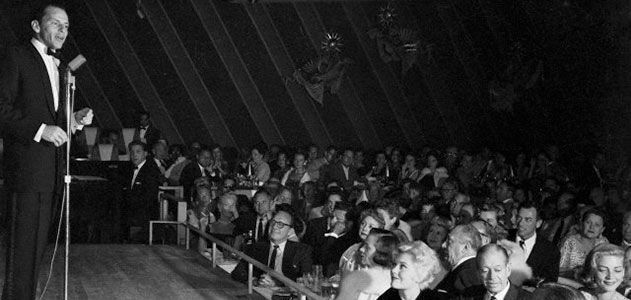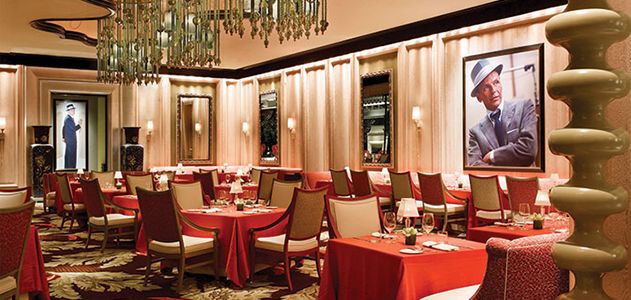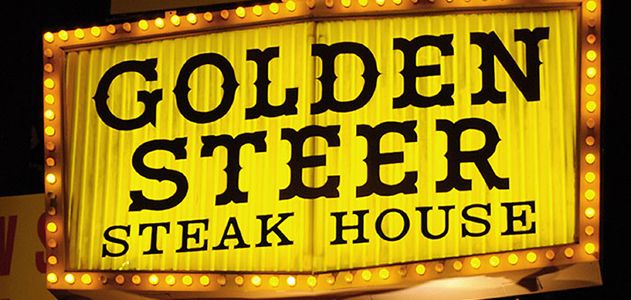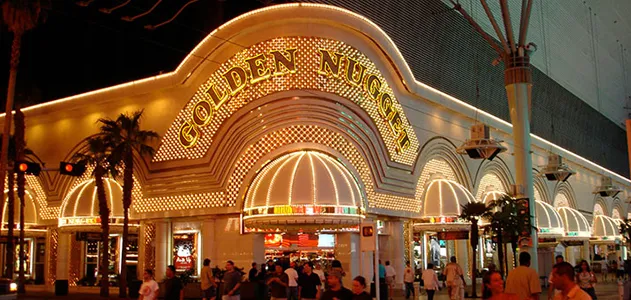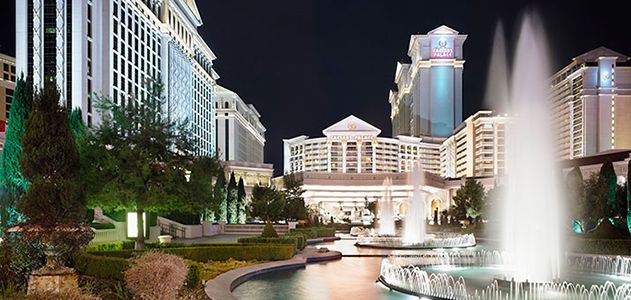How to Tour Frank Sinatra’s Las Vegas
Even though most of 1950s Vegas is long gone, there are still many ways to relive the haunts of Ol’ Blue Eyes and the Rat Pack
/https://tf-cmsv2-smithsonianmag-media.s3.amazonaws.com/filer/Frank-Sinatra-Las-Vegas-Stage-631.jpg)
There were no bright lights illuminating Nevada’s Arrowhead Highway in the 1940s, just a long dark stretch of road that passed through the desert on the way from Salt Lake City to Los Angeles. The place that would become known as Las Vegas was a stolid Western town like any other, replete with cowboy hats and Levi’s jeans, two dude ranches and a couple of casinos, known as “chuck wagons.” If you’re imagining tumbleweed, you aren’t far off.
Meanwhile, a 20-something Frank Sinatra had just started out as a solo artist. Even as most young men his age went off to fight in World War II, Sinatra—exempt from service because of a damaged eardrum, a souvenir from the traumatic forceps birth that permanently scarred the left side of his face and neck—made his name as a crooner amongst bobby-sock-wearing female fans.
Despite a somewhat hardscrabble upbringing, the blue-eyed boy from Hoboken, New Jersey, dreamed big, idolizing Bing Crosby and utilizing his charge account at a Hoboken department store so extensively that his top-shelf wardrobe earned him the nickname, “Slacksey O’Brien.” Sinatra’s early style sense would come to define his on-stage persona and ultimately the city of Las Vegas during the four decades he headlined there, beginning in 1951.
“Frank wouldn’t go out after dark without a sport jacket on, let alone perform out of a tuxedo,” says former Lieutenant Governor and 50-year Nevada resident, Lorraine Hunt-Bono, who remembers Sinatra from his early performances. “He was the spark that changed Vegas from a dusty Western town into something glamorous.”
During the 1950s, Sinatra’s star was on the rise once again, thanks to a Best Supporting Actor Oscar for 1953’s From Here to Eternity, his stormy, high profile marriage to Ava Gardner (his second wife of four); musical hits such as “I’ve Got the World on a String” (1953); and critically acclaimed albums “In the Wee Small Hours” (1955) and “Songs for Swingin’ Lovers” (1956), with its blockbuster, “I’ve Got You Under My Skin.” At the time, Sinatra’s performance home was the Sands Hotel and Casino in Vegas, where he eventually became a corporate vice president.
At some point during this period, actress Lauren Bacall, traveling with her husband Humphrey Bogart, came across Bogart’s ragtag assortment of drinking buddies, Sinatra among them. “You look like a goddamn rat pack,” she famously remarked when she found them inebriated at a Vegas casino. The name stuck, and Sinatra took it with him when he assembled his own court. The stylish fivesome of Frank Sinatra, Sammy Davis Jr., Dean Martin, Joey Bishop and Peter Lawford went on to film the original Ocean’s Eleven at the Sahara in 1960, the first of their three movies together. They were also frequent performers at the Sands’ Copa Room, where they worked by night under the direction of band director Antonio Morelli, then imbibed until the wee hours of the morning. In a 1976 interview, Morelli’s wife, Helen, described a week known as the Summit, when the Rat Pack performed at the Copa Room in two shows an evening. “You have never in your life seen such madness,” she said. “You never knew who was going to appear. You never knew when they were going to show up. They spent the whole time playing tricks on each other, and of course, the audience loved it.”
Sinatra was a regular Sin City fixture until 1994, just one year before his final performance in Palm Desert, California. He died of a heart attack at Los Angeles’ Cedars-Sinai Medical Center in 1998. The Strip today burns brighter than ever, and many of Sinatra’s “Old Vegas” mainstays—the Sands and the Sahara among them—have since been demolished, blown up and paved over to make way for the next great neon sign. A few of Sinatra’s former haunts still remain, however, and there’s even a new joint that might just have met with his approval. The show must go on.
“The best steaks on earth” have made the Golden Steer an Old Vegas favorite since 1958, hosting everyone from Tinseltown starlets and pro-athletes to notorious Chicago mobsters, who must have felt right at home in the Steer’s dimly lit dining room, with its white tablecloths, tuxedoed waiters and red horseshoe-shaped booths. Sinatra, Dean Martin and the rest of the Rat Pack were regulars, and Sammy Davis Jr. would often head to the Steer after shows, since many of the hotels where he performed had segregated restaurants. Reserve a spot at Sinatra’s favorite table (commemorated with a brass plaque) and save room for one of the signature flaming desserts: cherries jubilee or bananas foster.
Shortly after billionaire Howard Hughes—whose public feud with Sinatra was well known (Sinatra starred in several movies for Hughes’ doomed RKO pictures, including the flop “Double Dynamite”)—purchased the Sands in 1967, the Chairman’s credit line at the casino was suspended. Drunk and angry, Sinatra left the gaming tables, returning at the helm of a speeding golf cart, which he allegedly smashed through one of the Sands’ plate-glass windows. After this legendary altercation, Sinatra began, in 1968, to headline at Caesars Palace hotel and casino.
In addition to a fresh start, the 1,000-seat Circus Maximus at Caesars offered Sinatra the opportunity to reach a larger audience and to command a bigger salary; it would become the singer’s primary Vegas venue in the latter part of his career. When he played, the Las Vegas Fire Department worked overtime, trying to contain enthusiastic fans that spilled from their seats into the theater’s aisles and stairways. Caesars referred to Sinatra as "The Noblest Roman of them all”— a slogan printed on medallions the casino gave out to guests. When he was headlining, the marquee occasionally read, simply, "Guess Who?" and "He's Here.”
In 1959, Antonio Morelli, the famous orchestra conductor and musical director for the Sands Hotel and Casino, built a dream house for his wife, Helen, on an expensive tract of land known as the Desert Inn Estates. Morelli worked closely with Sinatra and the Rat Pack during their time as Sands headliners, and the troop would often rehearse at his home. A classic example of Las Vegas mid-century modern architecture, the house was relocated to Bridger Avenue and restored as a historical preservation project by the Junior League of Las Vegas in 2001. The Wynn Resort was built on its original site. Private tours of the Morelli House, now listed in Nevada’s national register for historic places, are available through the Junior League’s office.
In 1984, Sinatra and Willie Nelson inaugurated the Golden Nugget’s Theater Ballroom—a comparatively small space Frank supposedly nicknamed “the Dungeon.” For the three years that followed, Sinatra, at the twilight of his career, performed at the resort. The Theater’s intimacy and a recent abdominal surgery couldn’t dampen 71-year-old Sinatra’s spirits in a December 1986 performance, which was released posthumously in 2005 as “Live from Las Vegas." Recorded at the Nugget, it was the artist’s first major live Las Vegas album since 1966’s “Sinatra at the Sands.” Today, the 2,400-room hotel and casino is well known for its famous 200,000-gallon shark aquarium called “the Tank.”
Sure it’s a bit of Vegas kitsch, but Italian chef Theo Schoenegger’s Sinatra restaurant located in Encore at Wynn Las Vegas caters to serious Ol’ Blue Eyes fans. The menu specializes in Italian-American favorites such as hand-rolled spaghetti alla “chitarra” with tomato-basil sauce; chicken saltimbocca; and “Frank’s” clams possilipo, a Neapolitan recipe that was one of Sinatra’s favorite dishes at Patsy’s, his Manhattan retreat. Created in a collaboration with the Sinatra family, the restaurant displays priceless artifacts, including Frank’s Oscar for From Here to Eternity, a Grammy for “Strangers in the Night,” and an Emmy for “Frank Sinatra: A Man and His Music”.
Five Essential Frank Sinatra Tunes to Listen to Before You Go:
Lorraine Hunt-Bono and her husband, singer Dennis Bono, are both Las Vegas entertainment veterans and lifelong Sinatra fans. Here are their favorite picks from the Ol’ Blue Eyes library:
“Where or When” —Arranged by Billy Byers, Sinatra recorded this song with big-band leader Count Basie at the Sands Hotel in 1966.
“Come Fly with Me”—This fun, swinging version by Billy May was written at Sinatra’s request in 1957. It became the title track for the album, which was thematically designed—with tracks such as “South of the Border,” “April in Paris” and “Chicago”—to offer the listener a “musical trip around the world.”
“I’ve Got You Under My Skin”—Nelson Riddle was Sinatra’s most famous arranger, and his aggressive, punchy jazz style on songs such as this 1955 Cole Porter number helped to define Las Vegas’s own, belt-it-out musical genre.
“Fly Me To The Moon”—According to Quincy Jones, who arranged it, “Fly Me to the Moon” was a favorite of Neil Armstrong, Buzz Aldrin and the Apollo 11 crew, who took it with them (to the moon) in 1969.
“My Way”—Adapted from the French ballad, “Mon Habitude,” 1969’s “My Way” by Don Costa became one of the signature songs of Sinatra’s later career.
